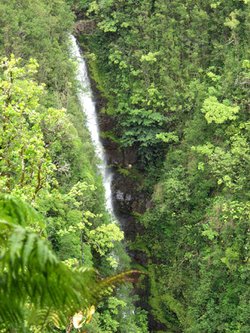Rainforest
|
|
A rainforest is a forested biome with high annual rainfall due to the Intertropical convergence zone. Some cite a minimum normal annual rainfall of 2500 mm (about 100 inches or 250 centimetres), with normal rainfall at least 60 mm during each of the twelve months of the year. Others set the minimum annual rainfall barrier as low as 1700 mm (about 67 inches). The soil can be poor because high rainfall tends to leach out soluble nutrients. This type of biome is found in both temperate and tropical climates. As well as prodigious rainfall, many rainforests are characterised by a high number of resident species and tremendous biodiversity.
Rain forests are home to two-thirds of all the living animal and plant species on the planet. It has been estimated that many hundreds of millions of new species of plants, insects, and microorganisms are still undiscovered and have no names yet. Tropical rain forests are called the "jewel of the earth", the "Earth's lungs", and the "world's largest pharmacy" because the large amount of natural medicines discovered there.
Despite the growth of flora in a rainforest, the actual quality of the soil is quite poor. Oxisols, infertile, deeply weathered and severely leached, have developed on the ancient Gondwanan shields. Rapid bacterial decay prevents the accumulation of humus. The concentration of iron and aluminium oxides by the laterization process gives the oxisols a bright red color and sometimes produces minable deposits (e.g. bauxite). On younger substrates, especially of volcanic origin, tropical soils may be quite fertile.
The undergrowth in a rainforest is restricted in many areas by the lack of sunlight at ground level. This makes it possible for people and other animals to walk through the forest. If the leaf canopy is destroyed or thinned for any reason, the ground beneath is soon colonised by a dense tangled growth of vines, shrubs and small trees called jungle.
| Contents |
Trees
There are several common characteristics of tropical trees. Tropical species frequently possess one or more of the following attributes not commonly seen in trees of higher latitudes.
Many species have broad, woody flanges (buttresses) at the base of the trunk. Originally believed to help support the tree, now it is believed that the buttresses channel stem flow and its dissolved nutrients to the roots.
Large leaves are common among trees of the C layer. Young individuals of trees destined for the B and A layers may also have large leaves. When they reach the canopy new leaves will be smaller. The large leaf surface helps intercept light in the sun-dappled lower strata of the forest. Drip tips facilitate drainage of precipitation off the leaf to promote transpiration. They occur in the lower layers and among the saplings of species of the emergent layer (A layer).
Trees are often well connected in the canopy layer especially by the growth of woody climbers or lianas. Plants with epiphytic adaptations, allowing them to grow on top of existing trees in the competition for sunlight.
Other characteristics that distinguish tropical species of trees from those of temperate forests include:
Exceptionally thin bark, often only 1-2 mm thick. Usually very smooth, although sometimes armed with spines or thorns.
Cauliflory, the development of flowers (and hence fruits) directly from the trunk, rather than at the tips of branches.
Large fleshy fruits attract birds, mammals, and even fish as dispersal agents.
Source of drugs
Tropical rain forests are called the 'world's largest pharmacy' because the large amount of natural medicines discovered there. Nearly half of the medicines that we use come from the rainforests.
Oxygen producer
It is sometimes estimated that rainforests provide up to 40% of the oxygen currently found in the atmosphere (this figure is strongly disputed by some groups and scientists, e.g. [1] (http://www.cfact.org/site/view_article.asp?idCategory=5&idarticle=274), who say that it is only young, fast-growing trees that produce oxygen, and even that the rainforests may be a net consumer of oxygen). And yet, tropical and temperate rain forests have been subjected to heavy logging and agricultural clearance throughout the 20th century, so that the area covered by rainforest around the world is rapidly shrinking. Another form of destruction in the rain forests is the burning of trees. It is estimated that the rainforest was reduced by about 58,000 km² annually in the 1990s. Rainforests used to cover 14% of the Earth's surface. This percentage is now down to 6% and it is estimated that the remaining natural rainforests could disappear within 40 years (mid-21st century) at the present rate of logging. Many scientists seriously dispute these estimates, especially considering the rapid growth of new tropical rainforests in cleared areas, though these second-growth forests are much poorer in biodiversity. Biologists have estimated that large numbers of species are being driven to extinction, possibly more than 50,000 a year, due to the removal of habitat with destruction of the rain forests. Many charities and conservation organizations use donation money to protect the rainforest trees from logging.
Rainforests
The largest tropical rainforests exist in the Amazon basin (the Amazon Rainforest), in the equatorial portions of the Democratic Republic of Congo, and in much of Indonesia east and south to Queensland, Australia. Temperate rainforests are found along the Pacific coast of North America from Alaska south to northwest California, in the former Yugoslavia, in parts of Japan, New Zealand and Tasmania, Australia. Most temperate rainforests result from prevailing upslope flow along a mountain range.
Rainforest Pictures and Clipart
- Geography Pictures (http://classroomclipart.com/cgi-bin/kids/imageFolio.cgi?direct=Geography)
- Rainforest Pictures (http://classroomclipart.com/cgi-bin/kids/imageFolio.cgi?direct=Geography/Rainforest)
- Environment Clipart (http://classroomclipart.com/cgi-bin/kids/imageFolio.cgi?direct=Clipart/Environment)
- Geography Clipart (http://classroomclipart.com/cgi-bin/kids/imageFolio.cgi?direct=Clipart/Geography)
- Clipart (http://classroomclipart.com/)

